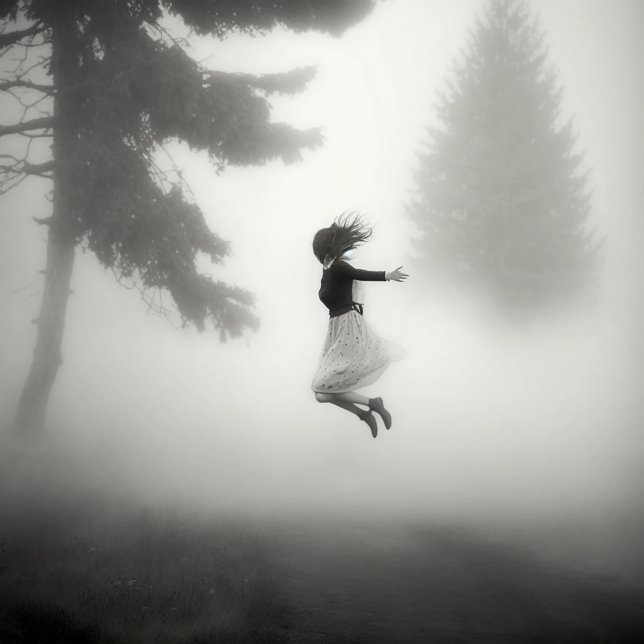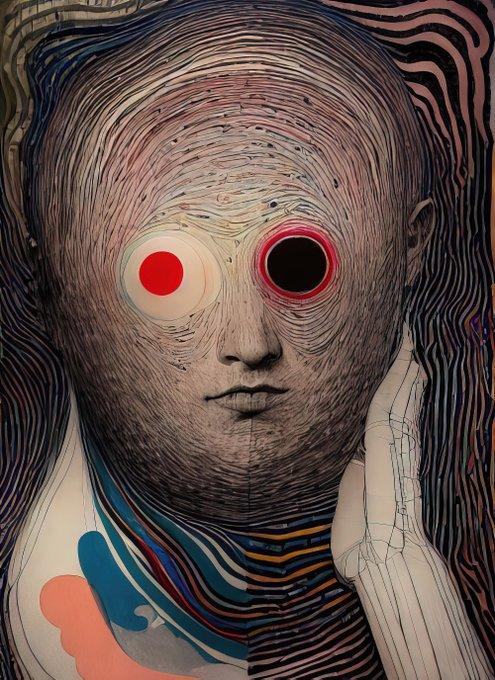Impressum, Datenschutz, AGBs
Copyright 2025. Alle Rechte vorbehalten.
I, A(I)RTIST – Art in the Age of AI
AI is a tool that influences art. That’s a fact, regardless of what your opinion is. Similar to photography 150 years ago, AI will influence a wide variety of art genres. Architecture, painting, digital art, photography, etc. will be affected. Perhaps its own genres will develop.
The exhibition I, A(I)rtist -Art in the Age of AI takes a look at Digital Art/NFTs. The spectrum ranges from non-representational moving images, which have their starting points in color field painting, to image-generated memories created by means of photographs.
Linda Dounia
Linda Dounia is an artist and curator from Senegal. In her work, she explores the social constructions of power and the cultural implications of the distribution of power. She creates her moving AI images from a mix of physical and digital media.
Linda takes an important position beyond the art context because, as an African woman, she advocates for the representation of non-Western perspectives in the GAN scene. Linda’s own approach is the decolonization of art and design, for which she creates spaces where marginalized art makers can become visible and create their own work.
Mchx
Anton Dubrovin is originally from Kazakhstan. After moving to Moscow in 2014, he focused on his artistic work. He taught himself the basics of composition, color theory, art history, and learned to code to program his own website. He was inspired by the color theory of Josef Albers, the works of Mark Rothko, Yves Klein and later Rupprecht Geiger. Today, using graphics programs, codenames and AI, Dubrovin explores the possibilities of color field painting in the digital. He is particularly influenced by 20th century works and ideas, abstract artists* and the color field movement, and sees color as a universal connection of emotion and self-discovery.
Dubrovin has exhibited in China, St. Petersburg, Kunsthalle Zurich and Tokyo and prefers to work with platforms such as StyleGan2, Playform, Runwayml and Dalle2, where he can use his own works as datasets for experimentation. He currently lives in Georgia, Batumi.
Memoakten
Memo Akten is a multidisciplinary personality. He is an artist, experimental filmmaker, musician and computer scientist from Istanbul. He holds a PhD in Artificial Intelligence from Goldsmiths University of London and is an Assistant Professor of Computational / New Media Art at the University of California, San Diego. He works with new technologies and computers as a medium and has worked for U2, Depeche Mode, Google and Apple.
In 2013, Memoakten received the Ars Electronica Prize for his work “Forms.”
Memoakten’s art is primarily concerned with the depiction of human emotions and relationships. He shows both the beauty and the difficulties of living and communicating together. He often uses abstract shapes and colors to depict the intensity of emotions.
Another important theme is nature and the connection between people and the environment. Memoakten shows here the vulnerability of nature and emphasizes the responsibility of man for his environment.
This neural network has not been trained on anything. It is completely empty (i.e. randomly initialized) at the beginning. It opens its eyes for the first time and tries to “understand” what it sees. In this context, “understand” means that it is trying to find patterns and regularities in what it sees so that it can efficiently compress and organize the incoming information in the context of its previous experience and make accurate and efficient predictions about the future. But the network trains in real time, constantly learning and updating its “filters” and “weights” to try to improve its compressor, to find more optimal and compact internal representations, to build a more “universal worldview” on which it can hope to reconstruct future experiences. Unfortunately, the network also “forgets.” If too much new information arrives and it does not draw on previous experiences, it gradually loses the filters and representations needed to reconstruct those previous experiences. These ideas are not behaviors that I have explicitly programmed into the system. They are characteristic properties of deep neural networks that I exploit and explore.
The work “Hello World!” was originally created in 2017, published and mined in 2022.

Merzmensch
Merzmensch, Vladimir Alexeev, considers himself a futurist and dadaist artist He is a writer and researcher. Creative collaboration between man and machine is his theme. He focuses on the history of culture at the interface with new technology. He is an expert on digital experiences and an ambassador for the Open Ai community.
In his art and essays, Alexeev explores the horizons and possibilities of creative collaboration between humans and machines. He uses mixed media in his work, including his own poetry and photography, as well as advanced AI-driven models and approaches such as Dall-E and StyleGAN.
The pseudonym “Merzmensch” comes from the MERZ art of Kurt Schwitters, who is a great inspiration and spiritual mentor for Alexeev. In his works Merzmensch tries to follow the path of Schwitters and create new realms and realities from mixed media, where each element has its meaning and is equal to others.
Vladimir Alexeev was born in Moscow in 1979 and is currently based in Frankfurt.

Din Burns
Din Burns explores themes of the human psyche in his work. His portraits are often deconstructed and deformed. The Istanbul-based artist sometimes focuses on the state of permanent distractions. Burns seeks to depict the various states of the human soul through visual representations in his paintings. Fear, apathy, despair, shame, loss of identity and introspection, are constant motifs in his works.
Sasha Stiles
Sasha Stiles is a prolific Kalmyk-American poet, artist, and AI researcher who explores the confluence of text and technology and cross-media work. She holds degrees from Harvard and Oxford and lives outside of New York City with her husband and studio partner Kris Bones. Her work has been shown in prestigious exhibitions such as the Museum of Contemporary Digital Art, Miami Art Week, and New York Fashion Week, and she has won awards at the Future Art Awards. Sasha seeks to decode the hidden language of the dawning Novacene by combining elements of semiotics, translation, computer science, speculative design, visual poetry, and conceptual art. She is also co-founder of “theVERSEverse” and has published the book “Technelegy”.
Shardcore
Shardcore is the artist name of Eric Drass, an English artist and curator whose work explores themes of identity, consciousness, and the philosophical ramifications of artificial intelligence. His artistic mediums range from painting to digital installations to AI art with machine learning.
Drass holds a degree in Philosophy and Psychology from Oxford University and has co-authored a number of patents dealing with PRISM-like surveillance technologies, as well as a number of scientific papers on neural network models of language acquisition and heritability.In his work, Drass often transcends the traditional boundaries of art and his work is often political, playful, provocative or transgressive. His work has been featured and discussed in prestigious media outlets such as The Guardian, BBC4, and Wikipedia.Drass also had a brief career in the music industry as a member of an experimental hardcore band and has attempted to establish himself in the modeling and television business as a young man. His wide range of experience and knowledge contributes to his multi-layered and unusual artistic practice.
Ivona Tau
Dr. Ivona Tau, born in 1990, lives and works in Warsaw. She is an AI artist and researcher from Lithuania. A core element of her work lies in the intersection of art and photography and the new technologies of machine learning.
In the artificially intelligent tools, she wants not only to find emotions, but also to evoke them, thus making them more human.
Ivona holds a Master’s degree in Mathematics from the University of Warsaw and last year she received a PhD in Computer Science from the Polish-Japanese Academy of Information Technology. Her works have already been auctioned at Sotheby’s and on the important NFT sales platform hic et nunc she is among the top 50 artists.
To the work:
The Birth, and the Shared Memories of the Artist and the Algorithm, 2023
Early memories are vague and always blurred. Ivona Tau is inspired by this experience and sees parallels to the early stages of training neural networks.
Early memory visions resemble the colors and lights that imaging AIs fabricate at the beginning of their training. Abstract shapes and colors characterize the appearance, which only gradually becomes more concrete. Again and again, moments arise in which the viewer believes he or she can recognize something. Similar to the feeling when you think you can remember something.
In Ivona Tau’s case, these are memories that have faded so much that she can no longer see shapes or recognize places. The memory fragments are expressed through emotional features of color and movement.
In the case of the algorithm, Ivona shows the earliest stages of machine “learning” and “living.” These are the moments when the computer makes its first attempts to imitate reality. Here the images generated by the algorithm are still abstract. In a way, these are also its first memories.
Abstraction is not a static image in this work. Fluid transitions characterize the formal level of the images. For Ivona Tau, the AI is a kind of modern watercolor – one can influence its flow, but not completely control it.